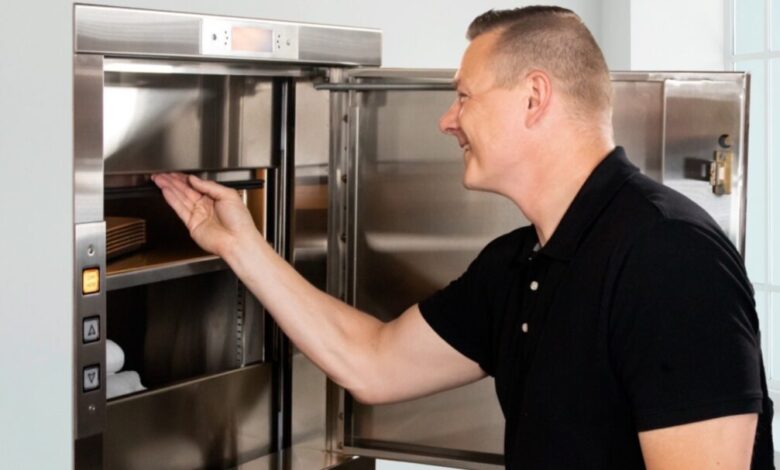Small Lift, Big Impact: The Growing Popularity of Dumbwaiters in Today’s World

As cities become more densely populated and space becomes a premium commodity, architects and designers are constantly faced with the challenge of improving building efficiency. In this climate, smart, space-saving solutions are in high demand. Enter the humble dumbwaiter: a small, unassuming lift that is gaining traction in residential and commercial buildings alike.
Originally designed to carry food or goods between floors, dumbwaiters are now being embraced for their versatility and efficiency. These lifts, which can be easily integrated into existing or new spaces, are proving to be indispensable in modern architecture.
Over the years, dumbwaiters have evolved beyond their original function of transporting food in restaurants and homes, taking on a more prominent role in many sectors. As buildings continue to shrink in size and maximise their use of space, the demand for these clever, compact lifts has soared, positioning them as a vital part of contemporary building design.
What Exactly is a Dumbwaiter?
A dumbwaiter is a small lift designed to move goods rather than people. Typically, they are installed in residential and commercial buildings to transport items between floors with minimal space and effort. Although the term “dumbwaiter” may sound quaint, these lifts are efficient, modern solutions to a variety of logistical problems.
Dumbwaiters operate using a simple mechanism: an automated platform is raised or lowered through a shaft, transporting items as small as parcels or as large as food trays. The lift can be controlled by either a manual system or through automated electrical controls, and it can be customised to meet the specific needs of the building.
Though originally designed for transporting food and small items, today’s dumbwaiters are versatile and can be used for a wide range of applications, making them an increasingly popular choice in buildings of all sizes.
The Practical Applications of Dumbwaiters
Dumbwaiters are found in many different settings today, offering a practical solution for transporting goods efficiently. Here are some of the most common applications where dumbwaiters have become indispensable:
Restaurants and Kitchens
In restaurants, particularly multi-storey venues, dumbwaiters are frequently used to transport food from the kitchen to dining areas on different floors. This allows staff to deliver meals quickly and efficiently without the need to climb stairs, improving service times and reducing physical strain.
Hotels
Hotels also make use of dumbwaiters, primarily for moving laundry, room service orders, and other supplies between floors. In larger hotels, dumbwaiters help to streamline operations, allowing staff to focus on service while ensuring that necessary items are transported without disruption.
Office Buildings
In offices with multiple floors, dumbwaiters can be used to transport files, documents, and other office supplies between departments. This allows for a smoother workflow and reduces the need for employees to spend time running up and down stairs, ultimately saving time and improving productivity.
Residential Homes
In private homes, dumbwaiters are increasingly becoming popular for moving groceries, laundry, or personal items between floors, especially in large or multi-storey homes. This reduces the need to carry heavy items up stairs, saving time and effort, and providing a more convenient solution for homeowners.
Why Dumbwaiters are Gaining Popularity
The popularity of dumbwaiters is growing, and several factors are driving this trend. As urban living spaces shrink and the demand for more efficient buildings increases, dumbwaiters are becoming an essential feature in both commercial and residential designs. Here are some of the key reasons why these lifts are gaining traction:
Maximising Limited Space
In today’s world, where square footage often comes at a premium, dumbwaiters provide a smart way to make the most of limited space. Their compact size means they can fit into tight areas, such as existing shafts, corners, or narrow spaces, where a larger lift would be impractical.
Enhanced Efficiency
Dumbwaiters increase efficiency by allowing items to be transported quickly and easily between floors. In busy restaurants, hotels, and office buildings, they save time and reduce the physical effort required from staff. With this added efficiency, businesses can streamline their operations and offer better service to clients and customers.
Safer Work Environments
Manually lifting heavy or bulky items up and down stairs can lead to workplace injuries, particularly in kitchens, hotels, or warehouses. By using a dumbwaiter, businesses reduce the risk of strain or accidents, ensuring that items are moved safely between floors without relying on manual labour. This is a crucial factor in industries where heavy lifting is a regular part of daily tasks.
Increased Demand for Sustainable Solutions
The growing focus on sustainability in architecture is also contributing to the rise in dumbwaiters. As energy-efficient and space-saving solutions are increasingly prioritised in design, dumbwaiters provide an environmentally friendly way to improve building operations without the need for extensive resources or additional space.
The Benefits of Installing a Dumbwaiter
Dumbwaiters offer a wide range of benefits for both residential and commercial buildings. From enhancing operational efficiency to improving safety, here are some of the key advantages of installing a dumbwaiter in your building:
Space Efficiency
Dumbwaiters are incredibly space-efficient, occupying far less room than traditional lifts or staircases. This makes them an excellent choice for buildings with limited space, allowing for smoother operations without compromising valuable square footage.
Improved Workflow and Productivity
In commercial environments like restaurants and offices, dumbwaiters streamline workflows by reducing the time spent transporting goods between floors. This allows employees to focus on more important tasks, improving overall productivity and service levels.
Cost-Effective
While the initial installation of a dumbwaiter can involve a cost, the long-term savings are substantial. By increasing efficiency and reducing the need for manual labour, businesses can save money over time, particularly in high-volume environments like restaurants or hotels.
Versatility
Dumbwaiters can be used in a variety of settings, from moving food in a restaurant to transporting laundry in a hotel. The versatility of these lifts makes them a practical choice for different industries and buildings, offering a convenient solution for many logistical challenges.
How Dumbwaiters Enhance Efficiency in Various Sectors
Dumbwaiters have been particularly impactful in industries where the movement of goods between floors is a regular part of the day-to-day routine. By reducing the amount of physical work required from staff and speeding up the transport process, these lifts have a profound impact on operational efficiency.
In Restaurants
In the fast-paced restaurant industry, dumbwaiters are used to send meals from kitchens to dining areas on different levels. This reduces the need for staff to run up and down stairs, saving time and allowing the kitchen staff to focus on cooking rather than logistics.
In Hotels
For hotel operations, dumbwaiters are a game changer, providing an efficient way to move laundry, food, or other supplies between floors. This helps staff avoid unnecessary trips between floors, keeping the workflow smooth and ensuring that guests’ needs are met more quickly.
In Offices and Warehouses
In office buildings, dumbwaiters help transport files, packages, and other materials between floors without disrupting the workforce. This also applies to warehouses or distribution centres, where items need to be moved efficiently to optimise storage and distribution processes.
In Residential Homes
Homeowners with multiple storeys benefit from the convenience of a dumbwaiter, which can save time and reduce the physical effort of moving heavy items. Whether it’s groceries, laundry, or personal items, the lift makes it easier to manage daily tasks.
SDLIFTS: Leading the Way in Dumbwaiter Solutions
As the demand for dumbwaiters increases, SDLIFTS has emerged as a leading provider of high-quality, customisable dumbwaiter systems. Known for their expertise and commitment to delivering tailored solutions, SDLIFTS is at the forefront of creating lifts that meet the needs of both commercial and residential buildings.
With a focus on safety, efficiency, and design flexibility, SDLIFTS offers dumbwaiters that integrate seamlessly into various environments, from high-rise hotels to private homes. Their dedication to innovation and customer satisfaction ensures that clients receive a product that enhances both the functionality and aesthetic appeal of their spaces.
The Future of Dumbwaiters: Innovations and Advancements
Looking ahead, dumbwaiters are set to continue evolving. As technology advances and buildings become smarter, dumbwaiters will become even more efficient, user-friendly, and energy-conscious.
Advancements in automation, connectivity, and smart technology will likely make dumbwaiters even easier to control and maintain. Features such as remote monitoring, predictive maintenance, and automated routing could make these lifts even more integral to the modern building.
The growing focus on sustainability in architecture also ensures that the future of dumbwaiters will be characterised by eco-friendly designs that reduce energy consumption while increasing performance.
As urban spaces continue to grow and evolve, the humble dumbwaiter is set to play an even more significant role in revolutionising the way we use and manage space in buildings, making it a truly invaluable addition to the modern world.



